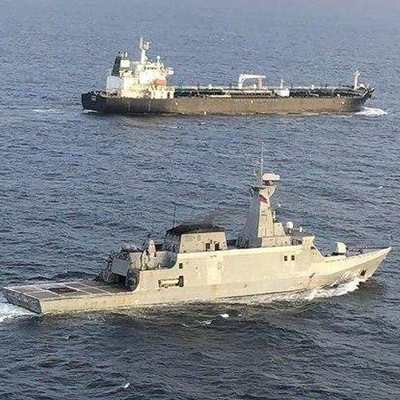Terms & Concepts
Escorting Oil Tankers
Mohsen Shir-Muhammad
86 دورہ
By the time of the Iran-Iraq War, Iran had implemented a policy of escorting ships and tankers to counter Iraqi attacks on maritime routes and oil tankers. The first instance of escorting non-combatant ships was during World War II when ships carrying weapons and military supplies from the United States to the United Kingdom were escorted to protect them against German submarine attacks.
During the Iran-Iraq War, the most significant escorts took place at sea en route to Bandar Imam Khomeini (ra). Over the eight years of the war, this port, due to its advanced road and railway infrastructure, modern cargo handling facilities, and capacity to host a high volume of ships (especially early in the war), offered superior capacity and operational efficiency in handling transit goods compared to other ports. Consequently, most commercial ships and some oil tankers operated along this route.[1]
Given the importance of Bandar Imam, the Iraqi army began attacking ships heading to this terminal in Khor Musa in early January 1981 until May 20 when the attacks intensified.[2] Also, by late August 1982, Iraq declared a no-navigation zone within a 35-mile radius of Kharg Island, warning that it would attack ships crossing this area. In September, naval clashes extended to the eastern waters of the Persian Gulf.[3]
As Iraqi attacks increased, Iran decided to protect ships bound for Bandar Imam by deploying naval vessels and fighter jets. In the summer of 1982, commercial ships began traveling in convoys from Bushehr to Khor Musa, escorted by sea and air forces.[4] To facilitate coordination among Iranian forces in securing maritime routes, a comprehensive plan named “Ajdar” was implemented by the Islamic Republic of Iran Navy, Air Force, Army Aviation, and Ground Artillery.[5]
Under this plan, all cargo ships and oil tankers heading to Bandar Imam Khomeini (ra) and Mahshahr would anchor in Bushehr after passing through the Strait of Hormuz, until a convoy of 16 to 20 vessels is formed.[6] Then, 24 hours before the convoy’s departure, necessary orders were issued to prepare the forces and deployed units for potential enemy attacks.[7]
Several days before each escort mission, a joint meeting would be held in which the representatives of the Navy, Air Force, and Army Aviation participate.[8] During convoy escorts, the Air Force provided continuous air cover until the ships docked. The escort team typically comprised two missile-launching frigates, one 65-ton or 85-ton frigate, a launch for intelligence operations, two high-speed boats operated by marine commandos, naval helicopters, and a firefighting tug. Moreover, commandos, when necessary, mounted guns on the ships to establish a defensive line. Thus, ships were escorted from Lavan Island to Bandar Imam or Bushehr.[9] The convoy mission, starting from Lavan Island or near Kish Island and ending at Bandar Imam or Bushehr, lasted 30 to 36 hours. Of course, escort missions were not limited to Bandar Imam; rather, ships were escorted back to the Strait of Hormuz after unloading or reloading.[10]
After operational units were prepared, a day before the convoy’s departure, another meeting would be held at the Bushehr Naval Base, which was responsible for overseeing the entire operation. Attended by all commanders, this meeting finalized coordination, assigned tasks to each unit, and set the deployment times, after which the ships began their journey. Typically, during these operations, The Iranian Army Navy warships escorted the convoy, Air Force fighter jets provided air cover, and Army Aviation (Havanirooz) was tasked with engaging Iraqi Super Frelon helicopters.[11]
In September 1981, the Ajdar Plan was modified and a new one named Ajdar 2 was introduced. Under this plan, the Cobra helicopters (Havanirooz) of the Army Aviation would counter enemy Super Frelon helicopters.[12]
Backed by foreign powers particularly France which had delivered advanced military equipment such as Super Étendard and Mirage aircraft and Super Frelon helicopters equipped with Exocet air-to-surface missiles, Iraq gradually gained greater capability to attack the convoys.[13] Therefore, Iranian authorities had to change the tactics of escorting convoys, and thus a new operational plan called “Temsah” was developed. Accordingly, the convoy escorts were conducted at night to limit the operational capabilities of enemy air units.[14]
As ships moved through the northwestern Persian Gulf, Iraqi forces deployed Super Étendard and Mirage fighter jets and Super Frelon missile-armed helicopters towards the convoys. Then, radars installed at Sarbandar and Bushehr would alert the Army Aviation flight team positioned at Khor Musa, ready for takeoff. At this stage, a Navy Sikorsky helicopter equipped with navigation systems and surface radars would join the Army Aviation flight team,[15] acting as the leader to guide the Cobra helicopters towards the target. Army Aviation pilots engaged Iraqi naval helicopters, allowing the convoy to continue its journey safely. In most of the cases, the Iraqi helicopters retreated, and some sustained damage. With Army Aviation helicopters participating in the Ajdar operation, no commercial convoy vessel was attacked by Iraqi helicopters. However, the mission of Army Aviation extended beyond helicopter engagements; during the operations, numerous Iraqi observation platforms and listening posts—both floating and land-based—in the northwestern Persian Gulf were targeted and destroyed by Army Aviation helicopter strikes.[16]
Throughout the war, more than 150 convoy escorts (approximately two per month) were conducted with each considered a distinct naval operation.[17] Escorting each convoy was a major undertaking, as it was the only way to deliver critical supplies, particularly wheat and raw materials, to the country.[18]
In 1987, as the Tanker War intensified, the United States began escorting Kuwaiti oil tankers. On August 22, 1987, the Kuwaiti tanker Bridgeton, while moving under the US escort, struck a mine. Americans claimed Iran had planted the mine. Following this incident, the US officially entered the Tanker War and, in October 1987, attacked Iranian military boats.[19]
During the Iran-Iraq War, Iranian Navy vessels escorted 10000 commercial ships and oil tankers by which 300 million tons of various goods were imported. Only 259 ships were hit by enemy attacks,[20] with 20 sustaining serious damage.[21]
[1] Shir-Muhammad, Mohsen, Bar Faraz-e Darya-ha – Negahi be Tarikh-e Havadarya va Hamaase-ye Eskadran-haye Havanaav, Balgard va Bal-e Sabet dar Jang-e Tahmili (Above the Seas – A Look at the History of Naval Aviation and the Heroism of Hovercraft, Helicopter, and Fixed-Wing Squadrons in the Imposed War), Tehran, Daftar-e Pazhuhesh-haye Nazari va Motaleat-e Rahbordi-ye NEDAJA, 1400, p. 173.
[2] Ibid., p. 174.
[3] Ibid., p. 209.
[4] Alaei, Hussain, Ravand-e Jang-e Iran va Araq, Vol. 1 (Course of the Iran–Iraq War), Tehran, Marz-o-Boom, 1391, Pp. 548–549.
[5] Manavi Roodsari, Abdollah, Negahi be Niroo-ye Daryayi-ye Artesh dar Hasht Saal-e Defa Muqaddas (A Look at the Iranian Army Navy during the Eight-Year Sacred Defense), Tehran, Iran-e Sabz, 1397, Pp. 48–49.
[6] Ibid., p. 49.
[7] Shir-Muhammad, Mohsen, Ibid., p. 177.
[8] Sayyari, Habibollah & Mansouri, Majid, Taqvim-e Tarikh-e Defa Muqaddas-e Niroo-ye Daryayi – Havadeth va Roydad-haye 1 ta 30 Bahman 1360 (Naval Defense Calendar – Events from February 1 to 20, 1982), Vol. 23, Tehran, Naval Strategic Studies Office, 1395, p. 73.
[9] Shir-Mohammad, Mohsen, Ibid., p. 175.
[10] Barzegar, Abdolrahman, Kahnamoei (Khaterat-e Naakhoda Yekom Sharif Farzadynia) (Kahnamoei – Memoirs of Captain Sharif Farzadynia), Tehran, Daftar-e Pazhuhesh-haye Nazari va Motaleat-e Rahbordi-ye Niroo-ye Daryayi-ye Artesh-e Jomhouri Eslami, 1391, Pp. 47–48.
[11] Manavi Roodsari, Abdollah, Ibid., p. 49.
[12] Mansouri, Majid, Tamin-e Khotoot-e Movaselati-ye Daryaie dar Hasht Saal-e Defa Muqaddas dar Yek Negah (Securing Naval Supply Lines during the Eight-Year Sacred Defense – An Overview), Tehran, Daftar-e Pazhuhesh-haye Nazari va Motaleat-e Rahbordi-ye NEDAJA, 1396, p. 44.
[13] Ibid., p. 42.
[14] Ibid., p. 43.
[15] Manavi Roodsari, Abdollah, Ibid., p. 49.
[16] Ibid., p. 50.
[17] Gorouh-e Ostadan-e Maaref-e Jang, Maaref-e Jang (War Teachings), Tehran, Iran-e Sabz, 1393, p. 457.
[18] Ibid., p. 175.
[19] Hameh Chiz Dar Mored-e Jang-e Naftkesh-ha (Everything about the Tanker War), Khabargozari Kharg, 20 Mehr 1398, https://www.khargnews.ir
[20] Manavi Roodsari, Abdollah, Ibid., Pp. 45, 48.
[21] Ibid., p. 48.





